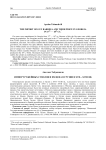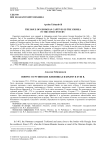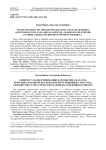Материалы по археологии и истории античного и средневекового Причерноморья @maiask
Статьи журнала - Материалы по археологии и истории античного и средневекового Причерноморья
Все статьи: 371

Lost hoard of roman coins presumably found in Northern Bulgaria
Статья научная
The object of the study is a coin hoard that probably belonged to a Bulgarian collector. The hoard was identified before the Law on Cultural Heritage came into force and there is no exact information about both its whereabouts and discovery. There are some reasons to believe that the hoard was found in Northern Bulgaria. The idea of its composition is only based on photos; the measurements and weights of the coins are not available. One hundred and twelve silver coins of the period 175-243 CE were deposited, specifically 111 denarii and one antoninian. One cannot be sure of the accuracy of the available information about the actual amount of the hoard. However, the coin complex deserves publication, since it enables the clarification of our understanding of the composition of monetary circulation in Northern Bulgaria in the 3rd quarter of the 2nd - in the 1st half of the 3rd century.
Бесплатно

New materials on sacrificial animals in Yanglang culture burials of the 5th - 3rd cc. BCE (China)
Статья научная
This article focuses on the analysis of the sacrificial animals remains in burials of the 5th - 3rd сс. BCE of the Yanglang Culture Wangdahu burial ground identified with the Western Rongs who lived on the Qin kingdom western borders. As a rule, Eurasia Cattle breeders placed one or two parts or livestock carcasses in ordinary burials. In contrast to them, in the Yanglang Culture in one person ordinary burial up to 30, 50 or more skulls of all major livestock species (horses, cattle, sheep and goats) could be placed. In the analysis of sacrificial animals from the Yanglang Culture burial grounds detailed description, the authors came to the conclusion that in a number of burials the composition of animal species and their ratio fully correspond to the Central Asia nomads’ herd averaged data. Apparently, the burial grounds organizers were sent real herd to the other world with the dead people or recruited animals for slaughter keeping the proportions known to them. The proportion of horses is much higher in the chariot warriors` burials which is associated with the deceased special status. As it turned out, even 1-3 years old children could have such status during burial in Wangdahu. Foals and votive weapons full set were placed in such burials. All of this suggests the chariot warrior’s high status which was established in the funeral rite. The maintenance and training of chariot horses large number, the horses and chariot warriors equipment manufacturing required the state structures participation. It is no coincidence that the number of chariots served as a state power yardstick in ancient China. All these preliminary observations and conclusions are consistent with indirect information from Chinese historical sources about the developed horse breeding among the Western Rongs, their special relationship with the Qin kingdom and possibly the early state formation existence among them.
Бесплатно

Статья научная
This article describes the wall-painting cycle of ornamental circles on the hanging shrouds which decorate the Cathedral of the Nativity of the Virgin in the St. Ferapont Monastery. Painted in 1502 by the artel of Dionysius, the frescoes represent the earliest extant tier of shrouds among the works of Old Russian monumental art. The iconography and symbolism of hanging shrouds in the church space are well-known, but the reasons why the ornamental circles appeared on the shrouds as well as their semantics and the idea of a special solution Dionysius had made for the tier are among insufficiently studied issues. The background tonality behind the shrouds, the compositional and rhythmic arrangement and the number of circles are analyzed. By referring to iconographic parallels in Judaic ossuaries and Old Russian sarcophagi and church decorations, the conclusion is made that the ornamental circles had the most ancient origin and the peculiar sacral significance; the unique is the conceptual solution proposed by Dionysius: the symbolism of the Byzantine liturgical hours could be reflected in his interpretation of the shrouds.
Бесплатно

Prohibitive and inhibitive factors of marriage in Samegrelo (Western Georgia)
Статья научная
Social relationships, including marriage, were regulated by ecclesiastical and secular laws as well as by customs in Georgian society. Various kinds of prohibitions existed. Today majority of the customs are lost because of globalization. However, customs concerning marriage restrictions are relatively well preserved in people’s memory. Different clans that do not marry each other were revealed by the ethnological research in historical-ethnographic region of Georgia - Samegrelo. Breaking marriage restriction by different socially related groups was strictly prohibited. Moreover, in some cases, clans or lineages which became relatives artificially had to follow the same strict rules of marriage prohibition. Different clans, lineages and patronymies studied by the ethnographic research conducted on the field, revealed the strength of the customs even today. The result of the research revealed, that prohibitive factors of marriage between different clans, lineages or patronymies were customary rules in Samegrelo, such are “ ginochama ”, serving to the same shrine, becoming relatives via Christianity and etc. However, marriage prohibition determined by Christianity affected only to minor lineages and patronymies rather than the big ones or clans. The memory of common origin is inhibitive factor of marriage, but not prohibitive similarly to the memory of past social inequality.
Бесплатно

Some notes on proper names and official titles in the mongol-un niuca tobciyan: inal/inanca/inaq
Статья научная
Mongɣol-un niɣuca tobčiyan, the “Secret History of the Mongol,” is the only work of its kind from the era of the Mongolian world Empire, it has a complex history as a text but was originally written in (Middle) Mongolian. It is a linguistically very rich source, not only for the Mongols but for many other groups who are seen allied with or appear fighting against the Mongols, the latter bearers of the power of Eternal Heaven and of the potent sanction of the ancestors. Thus, in addition to overt political assertions to guide the new Mongolian Empire, and its rulers’ managers, and commanders, and containing carefully selected and crafted statements of events of myth and history. These are designed to buoy up the imperial state of affairs and Mongolian society in general, Adapted documents and even works of a literary character are among the devices used to this end. Given its nature, it is only to be expected too that the “Secret History” also is a rich source of a full history behind the scenes of told by the personal names and epithets, and titles of Mongols, but also the names, epithets, and titles of many non-Mongols who had military, political and diplomatic contacts with the Mongols in the early 13th century. These names, epithets, and titles tell entirely their own story. Thus, grasping their potential importance, these names, epithets and, titles have been studied by many researchers, from a variety of perspectives.Here, we, a Mongolist and a Turkologist, have banded together, to follow in the footsteps of these investigators who have gone before, offering our historical-comparative analysis of the related words inal/inanča/inaq, and their semantic and morphological structure, examined within a larger context of the “Secret History” and its monumental, literary linguistic and cultural world. Our analysis will be primarily based on the “Secret History,” but also on other historical texts and documents, as well as information offered by Mongolists, but also provided by those in closely related disciplines, in Turkology in particular, for example, this is only natural since Mongols and Turks closely interacted in building an empire, and the new, often mixed cultures that emerged from it.
Бесплатно

Статья научная
One of the most important finds from the richest of the Thracian hoards, the Rogozen Treasure, is the so- called Auge Phiale. Its chronological position is crucial for the dating of the Hoard and had already been a point of debates. Its decoration, which consists of a mythological scene in high relief occupying the interior of the flat bottom and a relief pattern of alternating palmettes and lotus flowers grouped around the central rosette on the outside is discussed, thus allow us not only to determine the position of the vessel among the masterpieces of the Late Classical/Early Hellenistic metalware, but also to dwell on the genesis of the main subject of the composition. Clarifying the chronological position of the phiale is also extremely important for the establishment of the date, when the Treasure was hidden.Both the analysis of the general shape, the construction and composition of the elements of the vessel, the ornamental patterns decorating its bottom and the parallels of the figural composition on the inner medallion do not allow dating earlier than 350/340 BCE. Moreover, there is strong evidence that the phiale should be dated in the chronological frames of the last quarter of the 4th - first decades of the 3rd century BCE. The shape of the vessel and the decoration of its bottom may suggest a somewhat earlier dating, whereas that of the medallion - somewhat later, within the frames of the chronological period mentioned above. Thus, it may be a further confirmation of the history of the vessel, reconstructed on the grounds of its technological examination.This is not the only vessel from the Rogozen Treasure for which a dating after 340 BCE and as late as the last quarter of the 4th/early 3rd century BCE, first decades or even the second quarter of the 3rd century BCE has been already proposed. Consequently, it provides another argument that the Treasure was buried much later than it was usually suggested before (330s BCE).
Бесплатно

Статья научная
The paper is devoted to the complex analysis of silver objects from the burial complexes of Asian Sarmatia of the 2nd century BCE - 3rd century CE, representing both typological and cultural-historical analysis of these items in combination with the study of the isotopic composition of Pb in order to try to answer questions not only about possible centers of the manufacture of objects, but also of the sources of the metal. Pb-Pb data were obtained using inductively coupled plasma multicollector mass spectrometry (MC-ICP-MS) carried out in the Laboratory of isotopic geochemistry and geochronology of the Institute of Geology of Ore Deposits, Petrography, Mineralogy, and Geochemistry RAS, Moscow.The overwhelming majority of the objects are dated within the 1st century BCE - 1st century CE time span. The stylistic features of the items indicate that their origin is associated with several production centers: 1) the workshops of the ancient cities of the North Pontic region, first of all, the Bosporan Kingdom; 2) workshops located in Asia Minor or in the Eastern Mediterranean; 3) round-bottomed goblets and some of the phalerae of horse-harness should be attributed to the products of Sarmatian craftsmen, most probably manufactured both inthe Lower Volga and in the Kuban region; 4) a neck guard of the helmet of the East Celtic type, secondary used as a breastplate of horse-harness, is undoubtedly the product of the Celtic ( Taurisci ) workshop, located in the territory of modern Slovenia.The 17 silver items demonstrate substantial heterogeneity in terms of the Pb isotopic composition. The values of 206Pb/204Pb, 207Pb/204Pb and 208Pb/204Pb ratios vary in the ranges: from 18.07 to 19.41, from 15.60 to 15.75, and from 38.3 to 40.4 respectively. The large variation (ν206/204 = 1.4%, ν207/204 = 0.2%, and ν208/204 = 1.2%) can be explained by the origin of the metal from several ore provinces located in the Black Sea region, Asia Minor and the Near East. The Pb isotopic composition of most of the items is consistent with deposits in the Black Sea region - Eastern Balkans (6 items) and Eastern Pontides (6 items). The Pb-Pb data indicates that silver also could come from the deposits of the Taurus (South-Eastern Turkey) and Zagros (Western Iran) Mountains.
Бесплатно

Статья научная
Syrian and Armenian influence has been felt in the Old Bulgarian culture by different scholars, such as archaeologists and architecture historians as well as historians of the earliest Bulgarian writing and manuscripts. Some of them, looking for a possible source of this influence, pointed to resettling a large Syrian and Armenian population from the former Roman Armenia's lands in the Caliphate to northern Macedonia in the 750s. An exhaustive overview of the literary sources related to this resettlement (in Greek, Syriac, Arabic, and Armenian) demonstrates that took place a translatio urbis of Theodosiopolis/Karin (modern Erzurum) together with a great part of Christian population of the Great Armenia and Melitene. The immigrants created new cities where preserved and developed their local cults, including the famous cult of the Fifteen Martyrs of Theodosiopolis/Strumica.
Бесплатно

The cultures of the early iron age in China as a part of the Scythian world
Статья научная
Based on archaeological and written sources, the authors characterizes the two ethno cultural regions of the 9th - 3rd centuries BCE that developed in the east of the Scythian world - in Xinjiang and North China. In the 9th - 8th centuries BCE there, in local cultures of transitional appearance, burial complexes with “Scythian triad” individual elements in the Animal style in a horse bridle are recorded. It is obvious that both of these areas were the early Scythian cultures formation centers like the center in Tyva. At the same time, according to all sources, the Animal style was brought to the China territory from Mongolia. Due to natural factors, in these areas up to the 2nd century BCE Scythian cultures developed almost in isolation from each other in contact with the adjacent Kazakhstan, Southern Siberia and Mongolia regions. In the second half of the 4th century BCE the northern part of Xinjiang (including the Tien Shan) get closed culturally with Pazyryk culture of Altai, and then to the Sakas and Wusuns of Kazakhstan. At this time the North China cultures were in close contact with South Siberia population. At the same time, some Scythian-like features were preserved in them until 3rd - 2nd centuries BCE, even after the Han and Xiongnu empires formation at the end of the 3rd century BCE.
Бесплатно

The image of antelope (saiga) in the early iron age art of Kazakhstan
Статья научная
The aim of the study was to analyze images of antelope, specifically Saiga tatarica , among Early Iron Age artworks in Kazakhstan. The research is based on archaeological record from the so-called ‘Zhalauly hoard’, as well as from Taldy-2, Tasmola-5, Baike-2, Tagisken, and Issyk barrows to mention but a few. Antelope-shaped motifs appear on artifacts such as headdress, belt, bone case, weapons, and horse harness. It is Saryarka, the most spacious region of Kazakhstan, which provides the biggest sample of antelope representations. The widespread occurrence of saiga images lasted from the 8th to 5th century BCE, with some cases, like Issyk and Tasaryk, dating back to the 4th century BCE.
Бесплатно

The import of gun barrels and their price in Georgia in 17th - 18th cc.
Статья научная
Firearms were manufactured in Georgia from the 17th-18th centuries, as a result of which they were widespread among the population. In the 17th and especially the 18th centuries, Georgians, in large part, used firearms. In addition, the products manufactured in Tbilisi were distributed to neighboring countries. Flintlock rifles had three main components: the gun barrel, the flintlock and the stock. According to sources, in Tbilisi, shock-flint locks and butts were produced locally. When it comes to gun barrels, the picture is different. Typically, imported weapons barrels from Crimea were used to manufacture firearms in Tbilisi and the rest of Georgia. It is because of the Crimean barrels in Georgia that the most common name for firearms was "Kirimi" / "Hirimi". The Weapon Fund of Ethnology and Modern History of the National Museum of Georgia (Museum of Georgia named after Simon Janashia) contains hundreds of rifles with weapon barrels imported from Crimea. The import of gun barrels was well documented in the Georgian tax tariff, which allowed scientists to determine the prices of weapons at the time.
Бесплатно

Статья научная
The current migration routes may represent an excellent record while studying nomadic populations in the past. And although we can only extrapolate the current situation or the results of comparative studies to the past without equating them, migration routes may be used as research contexts of high reliability. The slopes of Sabalan Mountain in the northwest of Iran is among principal summer pastures used by the herders of the Shahseven tribes. Here, the vast majority of Iron Age sites are cemeteries not associated with settlements, so in the past the area was used by the nomads for their summer camps. During the research of migration routes of the modern-day Shahseven leading to the summer pastures, multiple Iron Age cemeteries, as well as fortified settlements and campsites, were discovered. In large-scale field investigations, archaeological sites were thoroughly surveyed to locate them in relation to current migration routes and to verify possible relationship between them. In the research area, sites were studied both by number and by categories, and the sought-for relationship has been established. It is obvious that the sites are concentrated along migration routes. Both on the mountain slopes and adjacent plains, traces of ten pathways of primary and secondary importance were recovered, and Iron Age sites are found throughout along them. Hence, some modern migration routes appeared to have been in use during the Iron Age, although the traditional ancient pathways may not have been entirely the same as modern ones.
Бесплатно

The issue of Georgian captives in the Crimea in the 18th century
Статья научная
Dagestani mountaineers were engaged in kidnapping people from eastern Georgia throughout the 16th - 18th сenturies. Part of the population kidnapped by the Dagestani mountaineers was dispatched to Istanbul by Turk merchants and part was transported to the North Caucasus, but most often, to the Crimea. In the course of time, the number of Georgian captives for slavery in the Crimea reached several thousand. According to King of Kartl-Kakheti Erekle II, in the 70s of the 18th century, their number made 32 thousand. After the end of the Russo-Ottoman war of 1768-1774, Georgian captives gained their freedom. At the end of 1771, Erekle II sent his envoys to Russia. One of the purposes of this mission was to settle the question of Georgian captives liberated in Crimea. Thanks to direct involvement of King Erekle II and Georgian diplomats, a significant part of Georgian captives managed to return to their homeland. Some of them stayed in Russia that was in the interests of the Russian state. The data on the captives who returned from Crimea to their homeland are reflected in Georgian historical documents.
Бесплатно

The political heartland of Chagatai khan in Zhetysu
Статья научная
The article examines the history of Zhetysu, during the period when this historical region was part of the Chagatai’s ulus. Special attention is paid to the Kegen-Narynkol district, which was the political center of this Ulus. The historical significance of this region is insufficiently covered in historical research. Kegen-Narynkol district is considered the seasonal political center of Chagatai and his descendants, their summer pastures were located here. It also describes the artificial ponds (reservoirs) preserved to this day in the Kegen-Narynkol steppes, the construction of which is associated with the rulers of the Chagatai Ulus. At the end of the article, the political situation in Kegen-Narynkol during the existence of the Kazakh Khanate under the rule of Yesim and Zhangir, as well as the general history of the Kazakh and Kyrgyz peoples, is investigated. The article uses information from written sources, as well as historical legends, pedigrees preserved by the Kazakhs and Kyrgyz.
Бесплатно

The role of Henry Martyn, a Christian priest, in confronting Iranian Shiite clerics
Статья научная
Henry Martyn (1781-1812), an English priest, during his tenure in India, decided to introduce Christianity not only among the Hinduists, but also among the Arabs and Persians, so he began translating the New Testament into Arabic and Persian to this end. In 1811, being a little familiar with Persian language and literature, he came to Iran and showed his translation to Iranian scholars who found it rather childish. Martyn resumed translating and had another trip to Shiraz to improve his Persian language skills. While in Shiraz, he confronted and challenged the Shiite clerics. His intention was to propagate Christianity, and he thus aimed more to invite and challenge the youth. Meanwhile, several treatises were written in response to his questions and doubts about Islam, and he also tried to refute these treatises in due course. The research was based on the archival record, and its main goal was to reveal and interpret the content of the messages of the Shiite clerics in response to Martyn's judgments as well as the content of Martyn's own responses to them. It turns out that during these religious debates and the opinion exchange between Islamic treatises and Martyn's writings, the missioner's utterances became less and less valuable to the Iranians, and especially to those who accepted his views, but he did not give up until Mohammad Reza Ibn Mohammad Amin Hamedani wrote the treatise “Guidance of the Misguided” to dispel Martyn's doubts. This treatise was the culmination of Martyn's anti-Islamic rhetoric in Iran. Failing to fulfill his religious mission, he left Iran without achieving his main goal of meeting Fath Ali Shah and Abbas Mirza to present the Persian version of the New Testament to them with his own hands, and soon after, on his way back home, he died in Turkey.
Бесплатно

Статья научная
In 451, after the Ecumenical Council of Chalcedon, Chalcedonism spread in Armenia, especially in Tayk. With its spread, Georgian penetrated there having an impact on the historic and cultural life and the ethnic image of the region. A part of the Armenians, breaking away from the Armenian Church, became Georgian-speaking. The study aims to analyze the process and the ethno-religious environment resulted from the impact of the new confession. In Tayk, a bishop’s seat was founded as early as the 4th century by Gregory the Illuminator, and it continued to be a diocese of the Armenian Apostolic Church, which is testified by the fact that the names of the bishops of Tayk have been remembered at church meetings etc. until the 9th - 10th centuries. Chalcedonism and Georgian writing and literature rooted in the region as late as the 9th - 10th centuries, when the Bagratunis, the local ruling elite, accepted the Chalcedonian confession. As a result, the population of Tayk and their rulers were called ‘Georgians’ or ‘Iberians’ in both Armenian and foreign records. In Tayk, even church ceremonies were performed in Georgian, though Armenian was also used.
Бесплатно

Статья научная
The study of Hebrew inscriptions from Çufut-Qal‘eh is a central topic of Hebrew epigraphy in Russia. For a long time, the central controversial question was whether Jews or Karaites could live in the Crimean castle cities, such as Çufut-Qal‘eh and Mangup, before the Tatar invasion of the 1230s. The almost two-century long study of the inscriptions included the analysis of chronological systems, naming patterns, lexical content, comparison with historical sources, archival data, statistical, topographical and architectural analysis, as well as many other approaches. Studying the structure of the inscriptions and viewing Hebrew epitaphs as a literary genre can provide additional insights on the attitudes towards life and death reflected in these inscriptions.
Бесплатно

Статья научная
The article is devoted to the study, restoration, and reconstruction of a poplar box originating from kurgan No. 13 of the Urysay-2 burial site. This box contained a set of ritual objects associated with a female “priestess”. The box was positioned behind the head of the deceased and was a low, square container with straight sides and a separate flat lid. The specific set of objects found in the box included a mirror, a cedar block, a “spoon” with traces of paint, a small organic vessel (leather? felt?), and silk fabric, supplemented by a small stone altar and a set of tools found nearby. During fieldwork, the box was removed in one block. Subsequently, an MRI scan was performed; a comprehensive set of procedures was conducted to identify the material of the finds, their physicochemical composition, conservation, and restoration; a 3D reconstruction of the box and the items was carried out.
Бесплатно

Статья научная
Three Greek inscriptions found in Mtskheta reveal interesting information about Ancient Iberian royal court. However, identification of each of the persons, especially the king, is quite problematic. Still, there are some possibilities to deal. King of Iberia is mentioned in all three inscriptions, one of them reveals his name fully, another one partially, while king’s name is lost in the third one, however, one passage may still give us some hints about his identity or at least about Roman aspirations of Iberian court. Queen Dracontis is known only from one inscription. As for the royal official - commander in-chief and the only minister of Iberian king Anagranes, he is mentioned in all three inscriptions, being himself the sponsor of all the constructions. The paper focuses more on the issue of identification of King Amazasp mentioned in these inscriptions and some other issues connected with the major topic.
Бесплатно

Two Pontos castles in Vezirk"opr"u, reg. Samsun: B"uy"ukkale (Sagylion) and K"uc"ukkale
Статья научная
Vezirköprü, the district of Samsun, is an area of a continuous sedentism for millennia, from the Chalcolithic and Early Bronze Age until the present, due to its location at an important crossroads, with wide plains and numerous streams all around, and a landscape suitable for settled life. Being a village named Phazemon, in Strabo’s words, the site gained the identity of a city with the Roman domination in the region and took the name Neoklaudiopolis (Neapolis). The city has witnessed many wars and showed that it had an important strategic position. Mithridates VI Eupator, King of Pontus, was the biggest enemy of Roman domination in Anatolia back then. In Pontus’s coastal parts, castles have already been known, while those in the inner parts of the region have not been adequately researched. Büyükkale and Küçükkale, which are the scope of the paper, are among the latter. Both castles display many things of traditional Mithridatic fortification, with castle walls, rock tunnels, stairs, and tombs. The one in Büyükkale is identified with Sagylion of old written accounts. The castles under study have not yet been published elsewhere, and the paper is expected to contribute to the illumination of the construction activity of the Pontic Kingdom and the Hellenistic Period in Vezirköprü.
Бесплатно

